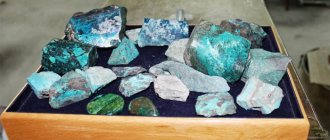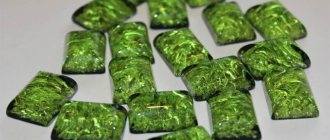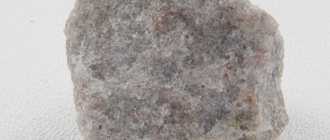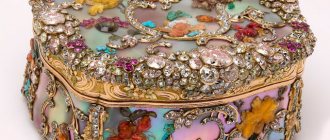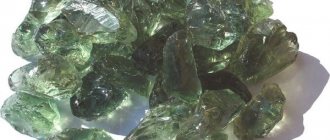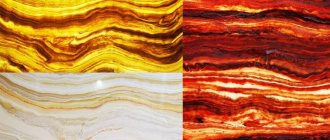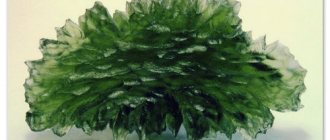Story
The name of the stone is translated from Greek as “cross”: “hias” means “cross”.
The ancient peoples knew about it:
- The indigenous people of America created the legendary history of chiastolite. The Araucan Indians turned the “stone with a cross” into an amulet against dark forces. During the Spanish Conquest, a cross on a stone embodied the souls of local soldiers who died in the fight against the invaders.
- The warlike Celts saw in it the focus of a force similar to a lightning strike.
The finest hour of the chiastolite struck with the beginning of the era of Christianity. The first adherents of the new faith made it their amulet.
The stone was discovered in Andalusia in 1754, near the pilgrim route of the Way of St. James of Campostela. This is the patron saint of wanderers, so they began to wear chiastolite as a talisman.
History and legends of origin
Chiastolite stone is considered a variety of Andalusite and is characterized by the interesting inclusion of carbon in the form of a dark cross in the center of the gem. In nature it is found together with stones such as Corundum and Kyanite. It can also be found in igneous rocks such as granite.
Scientists identify several versions of the process of formation of an unusual type of stone. The most common is considered to be a change in the mineral under the influence of external factors.
As the crystals grow, they accumulate carbon impurities, and in certain places (corners). As inclusions increase, the growth of the crystals themselves slows down.
Chiastolite
Graphite forms radial aggregates that are absorbed by andalusite, hence the inclusions are concentrated into an unusual pattern. “Growth-Slowdown” is repeated, resulting in the formation of a “cross” in the mineral.
Such an unusual name for the mineral comes from the Greek “kiastos” and means “marked with a cross.” Other peoples called the stone “lapis-crucifer” (crucifix stone). It was used as a remedy for evil spirits.
Chiastolite has an opaque structure
The first chiastolite was discovered in 1754 in Spain. All people knew about the unique properties and unusual appearance of chiastolite, regardless of location.
The Celts used the mineral as a sign of identity. In the area where the Araucanian Indian people live, several rock deposits of chiastolite are found. The presence of crosses in the mineral for this people is the soul of the warriors who refused to be slaves and gave their lives in the fight for lands with the Spaniards.
Description
The mineral is an opaque, rather fragile agglomerate of a warm color with a glassy luster.
Typical colors of chiastolite are red-brown, gray, yellowish-brown. Less common are white, greenish, pinkish specimens.
The sign by which chiastolite is identified is dark intersecting lines. It looks like a cross, which appears more clearly in the cut.
Other names for the stone are maltesite, crucite, and cross stone.
In medieval lapidariums (books on minerals) it is referred to as lapis crucifer (crucifix stone).
Origin
The origin of the mineral is metamorphic, it is formed in carbonaceous or clayey rocks:
- The “cross” is formed when andalusite crystals grow together.
- During the growth of the crystal, inclusions of these rocks are shifted and flattened until they are compressed.
- If the graphite-clay component predominates, triangles appear at the ends of the cross. They make the cross similar to the Maltese one.
The stone has been known since pre-Christian times (that is, more than two thousand years). But it was scientifically described by the German scientist Dietrich Karsten only in 1800.
Chemical composition
The silicates group includes many different stones. Only a few are considered precious. This precious mineral is a derivative form, a separate variety of andalusite. It is dominated by aluminum, silicon and oxygen, the formula is as follows: Al2(SiO4)O. In structure, these are crystals fused in a special way, with graphite and clay inside, which pierce it diagonally from the center, creating a beautiful pattern: a black cross on a coffee background. Sometimes the overall background is dominated by red, yellow, white, green shades - visually the stones can differ quite greatly from each other. The color is determined by the amount of manganese in the composition. The hardness of this mineral on the MOSS scale is 5.5 units, that is, it is relatively soft and its surface needs additional protection.
Physico-chemical characteristics
According to the chemical classification, the mineral chiastolite is an aluminum silicate. Its formula and composition are similar to andalusite. This is natural, since chiastolite is a type of this stone.
| Formula | Al2SiO5 |
| Color | Whitish-gray, grayish-yellow, brown, gray, pinkish-gray, bluish-gray, yellow, green |
| Stroke color | White |
| Shine | Glass |
| Transparency | Opaque, translucent |
| Hardness | 6,5 |
| Cleavage | Imperfect |
| Kink | Uneven |
| Density | 3.12 - 3.18 g/cm³ |
| singonia | Rhombic |
| Refractive index | 1,641 — 1,648 |
Inclusions reduce the strength of chiastolite.
Place of Birth
Chiastolite deposits are scattered across all continents. The raw material standards are different:
- Spanish stones from Andalusia are pleochroic and fluoresce.
- In Italy, red-brown, pink, light gray stones with a greenish tint are mined.
- Australia is saturating the market with howdenite. These are twin crystals, named after the place of extraction (the foot of Mount Howden). They are small, up to 4 cm, but with a pattern in the form of imprints of fern leaves.
- In the American state of Massachusetts, yellow, brown, brownish-red stones with a diagonal (as in St. Andrew's flag) cross are found.
- Russian deposits are concentrated in the Urals (Ilmen Mountains) and Transbaikalia. The former are famous for large samples (up to 10-11 cm), while red and brownish samples are extracted from the latter.
Significant production is carried out by Spain, China, Canada, Germany, Brazil, and France. The stone is found in Chile, Algeria, Myanmar, and Sri Lanka.
Where is the stone used?
The area of application of the mineral determined its appearance. Since the first centuries of Christianity, stone has become the material for rosaries, icons, crosses, and other religious objects:
- The significance of the stone was realized by the participants of the Crusades to the east beyond the Holy Sepulcher. Everyone had a body amulet.
- Masonic attribute - chiastolite with a Maltese cross in a ring.
- The mineral is polished into a cabochon or round beads are machined. They are used to make rosaries and pendants. The frame is almost always the simplest, in the spirit of Christian ethics.
- Particularly high-quality specimens are faceted - these are inserts for rings.
Products from Chiastolite
In secular jewelry, bright gems are used, framed in white gold or silver. When buying jewelry with chiastolite, you need to be prepared for increased attention from others.
- A popular interior item is a stone ball on a stand.
Collectors hunt for white stones with a clear black cross.
Which zodiac sign does it best suit?
According to its characteristics, the mineral is ideal for Libra, because it has a lot of harmony, and people born under this zodiac sign have a constant need for it. If there is not enough beauty and harmony around, Libra suffers and feels a loss of strength. Chiastolite will solve this problem.
This precious mineral is perfect for the zodiac sign of the Earth element - Taurus, Virgo, Capricorn. What should people with the zodiac sign of the elements of Fire or Water do? Who else from the Air element, besides Libra, should wear it? Chiastolite is the most versatile of all gemstones. It suits everyone. Protects against anger and envy.
It is also able to protect the house, help create an ideal atmosphere in the room, and destroy negative energy coming from the environment. It’s a good idea to complement your interior design with some decorative element made of chiastolite.
A fairy tale is dedicated to the mistress of the copper mountain; there are still heated debates about the philosopher’s stone today; the Tunguska Meteorite was found. The properties of stones and their chemical composition can tell scientists a lot, and interest in them continues unabated, even though it’s the 21st century. Man is part of a huge energy space called the Universe. The influence of planets and stones on his fate, life, and health is not denied by science, because there are no rational reasons for this.
How to care
The mineral is fragile, but it is easy to care for:
- Chiastolite must not be dropped or manipulated mechanically.
- Dirt is washed off with running water at room temperature. Can be used with baby or other neutral soap.
- The darkened chiastolite is left in water overnight along with the hematite.
- To preserve the color of the stone, the product is protected from harsh sun.
Chiastolite is immune to energy dirt, but it needs recharging.
The mineral is recharged by exposing it to the light of the full moon. If there is a suspicion of a magical attack or attack, you can cleanse it on the new moon.
How to distinguish an original from a fake?
Chiastolite is a semi-precious stone and is popular among users. This popularity has led to the spread of fake gems. Fake stones are often made on the basis of chrysoberyl, smoky quartz and tourmaline, which are very similar in appearance to the cross stone.
It is not easy to distinguish an original from a fake, but it is possible. The main criterion for natural stone is the cross. Its lines must run across the entire surface, without refraction or interruption at different angles and in any lighting.
Price
Russian online stores offer to buy collectible material and jewelry made of chiastolite at an affordable price (RUB):
- tumbling (China 1.5-2 cm) – 330 – 380;
- ball (33-36 mm) – 1,130 – 5,100;
- bracelet – 1,500 – 2,600;
- bead – 120-190;
- pendant (silver) – 2,900 – 3,400;
- ring (silver) – 3,100 – 3,800.
Chiastolite bracelet
This is the price of handmade products, there is no mass production.
Jewelry with mineral
To emphasize the originality of the crusader, the mineral is cut into flat oval plates or processed into cabochons. Jewelry with stones (earrings, pendants, rings), usually in a simple frame made of silver or white gold. Beads are used to create bracelets, rosaries, and necklaces.
The cost of jewelry is influenced by the place of origin of the stone and its size. The price of handicraft creations, unique in their kind, is, of course, always high.
- A pendant measuring 20 x 30 x 10 mm, without frame, costs approximately 1,300 rubles.
- A ring in an alloy frame with brass plating can be purchased for RUR 1,500.
- Bracelet made of chiastolite beads, 8–12 mm, – 9,500 rub.
- Beads, 4–20 mm, connected by copper, 100 cm long, – 18,000 RUR.
- Necklace size 50 cm, with handmade beads, with inserts of onyx, pyrite and silver – RUB 25,000.
Also read: Unakite is a unique relative of granite
Magic properties
External data predetermined the perception of the stone as a focus of mystical power.
Since ancient times, people have used the magic of chiastolite in rituals to drive out evil spirits. For sorcerers, it was a tool for communicating with other worlds and “reading” the past. They placed a stone in the area of the “third eye” or gazed at the pattern.
Esotericists have identified additional magical properties of chiastolite:
- It helps you concentrate and relieves you of guilt. This is used by monks and ordinary believers during prayer.
- This is the strongest home amulet against negative influences (natural elements, envy, damage, gossip).
- Particularly suitable for people associated with secret information, ordinary or sacred.
- It will help a creative person to believe in himself.
Its main meaning for a person is to remind him of his connection with God, to remember his love and forgiveness.
Meaning of zodiac signs
The stone is a universal patron for every zodiac sign, but is best suited for people born under the sign of Libra, Pisces and Gemini.
The mineral chiastolite is an excellent amulet for protecting people associated with the preservation or disclosure of various information. For example, it can be used by police officers, military personnel, journalists, editors, and accountants. The stone endows its owner with strong intuition and protection from wrong actions.
No zodiac sign should use chiastolite for the purpose of enriching or harming another person; chiastolite carries only positive energy and can return all negativity to its owner.
Therapeutic effect
Lithotherapists have studied the healing properties of chiastolite:
- Stops bleeding, improves heart function.
- Treats skin from burns, wounds, rashes, scabs, smoothes scars.
- Helps remove waste and toxins.
- Cures colds, bronchitis, pneumonia.
- Powerful antioxidant: normalizes metabolism, improves the absorption of nutrients.
- Beneficial for joints: treats gout, rheumatism, restores mobility to the limbs.
- Enhances lactation in nursing mothers.
Along with physical ones, chiastolite heals mental wounds: depression, despondency, nervous disorders. This is especially useful for children and adolescents.
Constantly wearing jewelry with chiastolite changes a person’s mood: problems do not seem insoluble.

